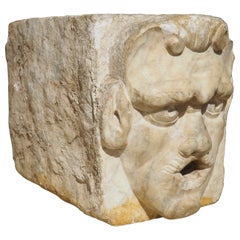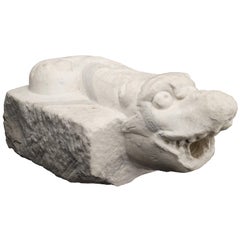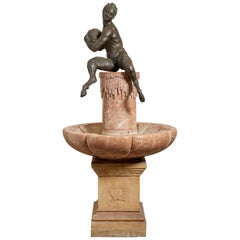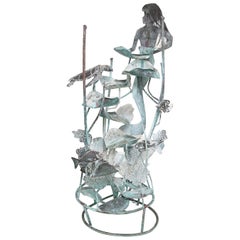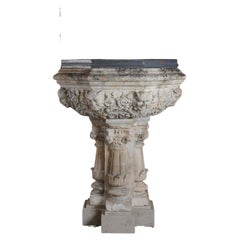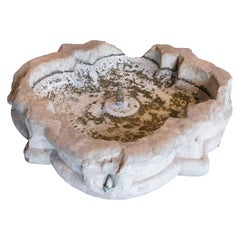16th Century Fountains
to
1
1
2
Height
to
Width
to
74
157
232
119
55
58
59
14
5
4
5
13
9
12
24
10
2
2
1
2
2
2
2
2
Period: 16th Century
15th or 16th Century Marble Gargoyle Fountain Spout from Arezzo, Italy
Located in Dallas, TX
Although when most people hear the word “gargoyle”, they probably envision small, winged creatures with grotesque visages. However, the phrase has a deeper meaning, encompassing any carved head (animal or human) that function as waterspouts.
From the Early Renaissance (late 1400’s/early 1500’s), our gargoyle fountain spout features a human-like face with pointed ears, possibly representing a centaur or a satyr. The roughly rectangular block of marble was hand-carved in Arezzo, in the Tuscany region of Italy. All sides except the front of the cream-colored stone have a sawed finish, resulting in a rough texture. The back has been excavated, adding to the character of the gargoyle. A 1 ½” diameter hole has been cut all the way through, forming an open mouth of the gargoyle. The gaping mouth was often a symbol used to conjure images of devouring giants and used to remind people that they are susceptible to certain forces.
Our 15th/16th century marble...
Category
Italian Renaissance Antique 16th Century Fountains
Materials
Marble
Italian Ancient Marble Sculpture Fountain, Late 16th Century
Located in Milano, IT
Sea monster
Carrara marble mouth fountain
Italy, late 16th century
It measures 13.8 x 31.5 x 18.9 in (35 x 80 x 48 cm)
State of conservation: some small evident gaps and widespread signs of wear due to outdoor exposure. The gray marks crossing it do not come from restoration, but are rather the natural veins of the marble.
This work has some morphological characteristics typically associated with the iconography of the sea monster: an elongated muzzle, sharp teeth, protruding eyes, elongated ears, and a coiled serpent's tail.
An in-depth series of studies on artistic depictions of the sea monster attempted to verify how this symbol evolved in antiquity in the European and Mediterranean contexts and how it gradually changed its image and function over time. The iconography itself is mutable and imaginative and its history is rich with cultural and artistic exchange, as well as the overlapping of ideas. This occurred so much that it is difficult to accurately pinpoint the "types" that satisfactorily represent its various developments.
However, we can try to summarize the main figures, starting from the biblical Leviathan and the marine creature that swallowed Jonah (in the Christian version, this figure was to become a whale or a "big fish", the “ketos mega”, translation of the Hebrew “dag gadol”). Other specimens ranged from the dragons mentioned in the Iliad (which were winged and had legs) to "ketos” (also from Greek mythology), the terrifying being from whose Latinized name (“cetus”) derives the word "cetacean". See J. Boardman, “Very Like a Whale” - Classical Sea Monsters, in Monsters and Demons in the Ancient and Medieval Worlds, in Papers presented in Honor of Edith Porada, Mainz am Rhein 1987, pp. 73-84).
In Italy the monster underwent yet further variations: it can be found in Etruscan art on the front of some sarcophagi representing the companion of souls, while among the Romans we find the “Pistrice” (cited by Plinio in Naturalis Historia PLIN., Nat., II 9, 8 and by Virgilio in Eneide: VERG., Aen., III, 427), which appeared in the shape of a stylized hippocampus or a very large monstrous cetacean and evolved into a hideous being with a dragon's head and long webbed fins.
During the Middle Ages, the sea monster was the object of new transformations: at this time, it is often winged, the head is stretched like a crocodile, the front legs are often very sharp fins - sometimes real paws - until the image merges with dragons, the typical figures of medieval visionary spirituality widely found throughout Europe (on this topic and much more, see: Baltrušaitis, J., Il Medioevo fantastico. Antichità ed esotismi nell’arte gotica, Gli Adelphi 1997).
In Italy during the 15th and 16th centuries, the revival of classicism - representative of the humanistic and Renaissance periods - led to a different reading of these "creatures". Indeed, the sea monster was also to find widespread use as an isolated decorative motif, especially in numerous fountains and sculptures where dolphins or sea monsters were used as a characterizing element linked to water (on this theme see: Chet Van Duzer, Sea Monsters on Medieval and Renaissance Maps, London, The British library, 2013).
From the morphological point of view, the "sea monsters" of this period are mostly depicted as hybrid figures, in which the body of a mythological or real being (a hippocampus, a sea snake, a dolphin), is joined to a head with a rather indistinct appearance. It was usually characterized by large upright ears, an elongated snout, sharp teeth and globular, protruding eyes; a complex and indefinite figure, both from the symbolic point of view and from that of its genesis.
The work we are examining is placed as a cross between the medieval sea serpent and the Renaissance dolphin, with stylistic features which recall the snake as often used in heraldry (such as the "snake" depicted in the coat of arms of the Visconti - the lords and then dukes of Milan between 1277 and 1447 - and which, for some, may be derived from the representations of the “Pistrice” that swallowed Jonah).
In the search for sources, Renaissance cartography and in particular woodcuts should not be neglected. See for example the monsters of Olaus Magnus, from the editions of the “Historia de gentibus septentrionalibus” (“History of the peoples of the north”) and the natural histories of Conrad Gesner, Ulisse...
Category
Italian Renaissance Antique 16th Century Fountains
Materials
Carrara Marble
Related Items
19th Century French Marble and Bronze Fountain
Located in Essex, MA
19th century French marble and bronze fountain. Seated satyr on marble column with marble shell basin. Later cast stone plinth. Wonderful garden ele...
Category
French Louis XV Antique 16th Century Fountains
Materials
Marble, Bronze
Copper Mermaid Fountain by Glen Mayo
By Glen Mayo
Located in West Palm Beach, FL
Whimsical fountain sculpture, of copper, by metal artist Glen Mayo; its mermaid focal point holding a leaf which cascades water down the fountain, among turtles, angel fish, other se...
Category
North American 16th Century Fountains
Materials
Copper
Architectural Studio Pottery Fountain by Piet Knepper
By Piet Knepper, Mobach
Located in London, GB
Fountain with two different tops by Piet Knepper for Mobach white glaze with copper oxide details and cracked surface, hand turned studio ceramic .
This is an example of Modern Scho...
Category
European Vintage 16th Century Fountains
Materials
Ceramic
Antique Italian Hand-Carved Marble Fountain with a Classic Fish Spout c1920's
Located in Chicago, IL
Antique Italian Hand-Carved Marble Fountain with a Classic Fish Spout, that was removed from a Chicago mansion. We have been told by the previous owner that the home where the antiqu...
Category
Italian Vintage 16th Century Fountains
Materials
Stone, Marble, Carrara Marble
$2,500
H 60.5 in Dm 35 in
Vintage Carved Marble Fountain or Planter
Located in Delray Beach, FL
Fantastic one of a kind carved marble architectural piece, can be used in deferent functions as fountain, planter or table top with the right bas,
beautifully carve in India in whi...
Category
Indian 16th Century Fountains
Materials
Marble
Large Water Fountain in Ceramic Mineral Finish
Located in Madrid, ES
Water fountain in hand painted ceramic.
Decorative ceramic fountain antique finish.
Category
16th Century Fountains
Materials
Ceramic
Wonderful Modernist Kenetic Motion Copper Fountain / Water Feature, Hand Made
Located in Buffalo, NY
Ingenious copper fountain / water feature, solid copper construction, Modernist design Artisan made, hand executed. Sculpture in motion, great for garden, or indoor space.
Category
American Mid-Century Modern Vintage 16th Century Fountains
Materials
Copper
Italian 19th-20th Century Whimsical White Marble Wishing Wellhead with Children
Located in Los Angeles, CA
A very fine and exceptionally carved Italian 19th-20th century Baroque Revival style whimsical white Carrara marble wishing wellhead, raised on an octagonal two-step marble base. The intricately carved marble relief circular wellhead depicting carved figures of dancing and cheerful children (Putti) among vines, flowers and fruits, dancing and playing musical instruments with a backdrop of castles, landscapes, forests and wreaths, Florence, circa, 1900.
Note: We have part II video of this amazing Wishing Wellhead. Please feel free to request a copy.
Literature:
A similar wellhead was sold by Jan's & Co. Fine French Antiques, Inc. in 1999, provenance the Atkinson/Kirkeby Estate and it is illustrated in "The Estates of Beverly Hills" by Charles Lockwood and Jeff-Hyland, page 150.
Another similar is currently on display at the gardens of "The Elms" mansion a public museum part of the Newport Mansions by The Preservation Society of Newport County in Newport, Rhode Island.
Yet another similar wellhead carved with frolicking putti with musical instruments and a dentil molded rim is located at Cranbrook House, Bloomfield Hills, Michigan, and is illustrated in B. Israel, Antique Garden Ornament...
Category
Italian Baroque Revival Antique 16th Century Fountains
Materials
Carrara Marble
$194,500
H 32 in Dm 51 in
Whimsical English 19th-20th Century White Marble Figural Outdoor Dog Fountain
Located in Los Angeles, CA
A Whimsical English 19th-20th century white marble figural fountain with dogs fountain. The Baroque Revival six-sided tripod marble base surmounted with three upright seated Yorkshire Terriers resting on a leaf and acanthus center stem, topped with a semi-circular scalloped carved basin...
Category
English Baroque Revival Antique 16th Century Fountains
Materials
Marble
$14,850
H 60.63 in W 30.5 in D 28.5 in
19th Century Antique Fountain Basin in Marble from Sicily
Located in West Palm Beach, FL
An antique rectangular fountain basin or in the style of the late Hellenistic period with minor repairs. This garden ornament features impressive mythological carvings of the art mus...
Category
Italian Hellenistic Antique 16th Century Fountains
Materials
Marble
Angelic Carved Wood Sculptures, 16th Century
Located in North Miami, FL
Pair of 16th Century Italian carved polychromed angelic sculptures.
Category
Italian Renaissance Antique 16th Century Fountains
Materials
Gold Leaf
White Carrara Marble Fountain
Located in Washington, DC
Fountain believed to be from from Turkey or Greece, 19th century and 20th century elements. The fountain is in working condition. replaced with modern marble carving elements to spou...
Category
Turkish Antique 16th Century Fountains
Materials
Carrara Marble
Previously Available Items
Important Renaissance Fountain in Limestone, Burgundy, 16th Century
Located in Walkertshofen, BY
Round pilasters projecting on four sides, set on an offset plinth, support the flared octagonal basin. The quarter-round base is decorated with dense, mannerist foliage, partly still adorned with scrolled acanthus scrolls. At the corners, mystical fauns look down, providing a glimpse into the era of the characteristic and magical fabulous creatures. Above, a peripheral profile with several steps forms the upper part, surmounted by a profiled lead basin. This fountain illustrates the masterly requirement of the stone sculpture work of the High Renaissance. Masterful craftsmanship in all its brilliance makes this fountain an important testament to architectural inspiration and museum quality. The realization is in limestone of Burgundy. Burgundy circa 1560. The lead basin and matching lead lion...
Category
French Renaissance Antique 16th Century Fountains
Materials
Stone, Limestone, Lead
16th Century Italian Renaissance Marble Fountain with Bronze and Lead F/ Spout
Located in Marbella, ES
16th century Italian Renaissance marble fountain with bronze and lead fountain spout.
Category
Italian Antique 16th Century Fountains
Materials
Marble
H 10.24 in W 31.5 in D 29.53 in
16th Century Limestone Fountain from the Bordeaux Region
Located in Dallas, TX
This limestone fountain origins from the Bordeaux Region in France, circa 1580.
Category
French Antique 16th Century Fountains
Materials
Limestone
Recently Viewed
View AllMore Ways To Browse
Marble Fountain Head
Swan Fountain
Antique Lavabo
Cast Stone Fountains
Dolphin Spout
Rare Antique Water Fountains
Rustic Stone Fountain
Bronze Outdoor Fountain
French Cast Iron Fountain
Iron Water Fountains
Vintage Copper Fountain
Octagon Fountain
Octagonal Fountain
Ceramic Fountains
Ceramic Water Fountain
Cherub Bronze Fountain
French Lavabo
Round Fountain Basin
